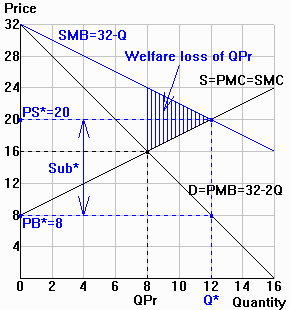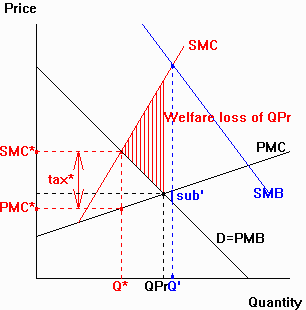|
1. |
a. | Suppose that the private (inverse) demand for
subscriptions to internet services (based on the private marginal benefits (PMB) of
individual internet users) is: P = 32 - 2Q and that the (inverse) supply is given by the following marginal cost equation: MC = 8 + Q. Equilibrium values: Q: 8 P: 16 P = MC => 32-2Q = 8+Q => Q=8 Q = 8 => P = 32 - 2(8) = 16. |
|
| b. | Use the axes to the right to show the private market equilibrium in a supply and demand diagram. |  |
|
| c. | Suppose that subscriptions to internet services generate
beneficial "network externalities," since the value of the service to each user
rises if there are more sites available to interact with. Suppose that these network
externalities are given by: XMB = 1Q. At the social optimum: Q: 12 MC: 20 PMB: 8 SMB = PMB + XMB = 32-2Q + 1Q = 32-Q. SMB = SMC => 32-Q = 8+Q => Q=12 MC = 8+Q = 8+12 = 20 PMB = 32 - 2Q = 32 - 2(12) = 8 |
||
| d. | Add a social marginal benefit (SMB) curve to your diagram, and indicate the welfare loss of the private market equilibrium. See shaded triangle in diagram. | ||
| e. | How large a subsidy would be necessary to push
the market equilibrium to the social optimum? Explain briefly, and illustrate it in your
diagram. Sub* = XMB at Q* = 1Q* = 12. (This also = MC-PMB at Q* = 20-8). In the diagram, this shows up as the distance between SMB and PMB at Q*. |
||
